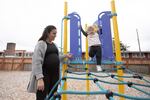
Liam Sollaccio, age 2, looks through a magnifying glass, Sept. 6, 2023, at Bumble Preschool in Astoria, Oregon.
Lydia Ely / InvestigateWest
Jess Sollaccio never expected it would be so difficult to find child care.
A tech worker living near Astoria on Oregon’s coast, Jess was making a good wage alongside her husband, Dan. Both work remotely, and during COVID, their employers understood their need to juggle caring for their 1-year-old son, Liam. But as society began coming out of lockdown and their bosses’ willingness to accommodate faded, Jess and Dan were thrust into the throes of a modern parenting frenzy: calling child care centers, joining parent groups on Facebook and, frequently, burning their paid time off to care for their son.
“It was a very eye-opening experience that I never thought I would have to go through,” said Jess. “It was desperation.”
Clatsop County, where the family lives, is one of the most difficult places to find child care in Oregon. The county’s supply of child care is so low that it can accommodate only 8% of its infants and toddlers, a state report found in 2023.
Yet although Oregon has invested tens of millions of dollars into expanding preschool and child care since 2019, that money has done little to improve access to infant and toddler care in some areas where it’s needed most, an InvestigateWest analysis of state data on child care supply has found.
Oregon has 11 counties that are considered “severe” child care deserts for infants and toddlers, according to the latest report from the Oregon Child Care Research Partnership. Of those counties, six don’t have any publicly funded child care spots meant to serve the lowest-income families at all. That leaves families of all incomes desperately competing for any open space.

Jess Sollaccio reads to her son Liam Sollaccio on Sept. 6, 2023, at Bumble Preschool in Astoria, Oregon.
Lydia Ely / InvestigateWest
The limited reach of state and federal support has forced local leaders in communities like the north coast region to scramble for ways to increase supply and financial aid for families. But those solutions, they fear, may not be sustainable.
“I think sometimes that the world is flipped upside down, because these kids are going to be caring for us and running the country one day,” said Courtney Bangs, a Clatsop County commissioner. “I think we’ve done them a disservice by not providing them the services they deserve, or by presenting their families with the choices they have to make.”
Alyssa Chatterjee, director of the Oregon Department of Early Learning and Care, said a variety of factors have contributed to slower progress in expanding child care access for infants and toddlers, including insufficient funding, infrastructure hurdles and workforce instability. She acknowledged that the shortage forces parents, usually mothers, out of work, or can steer children into programs with fewer safety or quality assurance measures in place.
“None of it is OK,” Chatterjee said. “We know families are choosing to have fewer children because of child care.”
The cost of the crisis
Oregon has several ways of subsidizing care and early learning to make it more affordable for lower-income families. But families on the central and north coast have fewer options than those in other regions.
Compare Malheur County in Eastern Oregon and Lincoln County on the coast, for example — two areas with a similar-sized population of babies and toddlers, and comparable rates of children under 5 living in poverty. A lower-income family in Malheur County can apply for a spot in Early Head Start or in the state-funded early learning program for their infant or toddler, because those programs offer more than 80 spots. A family of similar means living in Lincoln County doesn’t have that option, however, because those spots don’t exist.
Chatterjee said two of the obstacles to expanding infant and toddler care through those publicly funded programs is limited federal funding, and a greater societal emphasis on preschool for children ages 3 to 5. Now, she said, we’re playing catch-up to try to meet parents’ and children’s needs at a younger age.
“We need parents to be able to go to work, and there’s a lot happening with those babies developmentally,” Chatterjee said.
The state has increased funding for subsidies, such as the employment-related day care subsidy that lower-income families can use to pay a portion or all of a child’s care in the private market. But in counties like Clatsop, where more than 10 children might be competing for the same child care spot, that still leaves them in fierce competition.
The Student Success Act, passed by the Oregon Legislature in 2019, has so far brought a $37 million windfall to infant and toddler care that, in some communities, helped increase the number of part-time or full-day care spots offered by the state’s companion program to Head Start. But not along the north coast, where the program operator raised staff salaries to reduce turnover and expanded enrollment in its program of home visits and group meet-ups for parents with infants and toddlers.
To offer a full- or even part-day program for infants and toddlers would take both more building space and more people, said Joyce Ervin, program director.
“There’s definitely a need for working families to have full-time care,” she said. “At this point we’re providing the services we have funding for.”
But her organization did not apply for one of Oregon’s new Child Care Capacity Building Grants, which made $22 million available to providers across the state in 2022 to help them open new facilities or expand existing programs to serve more children. Few providers from the coast region did, according to a member of the committee helping allocate that funding.
“I don’t know the deep-rooted reasons,” said Dana Hepper, policy and advocacy director for the Children’s Institute, a Portland-based advocacy nonprofit. “I just know that just creating the funding alone isn’t adequate. We need to take a step back in terms of what support folks need before the funding even becomes available.”
Sen. Dick Anderson, R-Lincoln City, said he has tried to base his own support of investments and initiatives on feedback he receives from child care professionals in his own district. His bill launching a pilot program of “micro” child care centers in Oregon, an effort to ease some of the logistical and financial obstacles providers face when expanding or opening new facilities, was passed into law this year.
“We just keep throwing money at it, and at the end of the day, (child care) is going to need to be subsidized,” Anderson said. “I’m glad we’re doing it, but it definitely is not enough.”
Other laws passed during the 2023 legislative session have tasked Chatterjee’s department with identifying barriers to bolstering the workforce and increasing child care infrastructure. By the end of 2024, the Department of Early Learning and Care must report to the Legislature on where obstacles lie and how to tackle them.
With so few choices available, families sometimes also wind up placing their children in care situations that aren’t prepared to meet their needs.
That was the Sollaccio family’s first experience in 2022.
Today, Liam, now 2, thrives at Bumble Preschool and Arts Center, a bustling, sunny center in Astoria, where children from infants to 5 receive developmentally appropriate play and learning. At any given moment during the day, children might be making art, playing on the playground, singing and dancing together, and learning how to share and respect each others’ boundaries.
But for most of 2022, Liam spent time at a center that Jess and Dan Sollaccio pulled him out of after they discovered he was being left in a high chair for hours in front of a television — a bad combination for both a child’s physical and mental development. Jess also learned that a staff member would sometimes put a sort of restraint on her son using a blanket to keep him from leaving his chair and waking up other children during naptime, she said.
“He was having significant behavioral issues … It was really, really hard,” Jess said, tears welling up in her eyes as she described the experience.
Being able to switch to Bumble, where the teachers use an arts and experiential learning-based approach to help children grow, was “a Godsend,” she said.
Jess said it was pure luck that he was able to get into it at all.
“I happened to call when there was an opening,” she said.
Bridging the gap
Bumble only exists as an option for the Sollaccios because Clatsop County leaders stepped in to make up for the lack of state investment.
Bangs, the Clatsop County commissioner, is one of a group of leaders in the region who created a new grant program to bolster child care providers to prevent closures, increase slots and expand financial assistance to families. It is funded through a mix of public and private funds, including American Rescue Plan money chipped in by the county and donations from the two hospital systems serving the north coast.

Jess and Liam Sollaccio play in the park outside Bumble Preschool, Sept. 6, 2023, in Astoria, Oregon.
Lydia Ely / InvestigateWest
She ran for county commissioner in 2020 partly because of her own experience having to leave her work as a teacher in order to care for her children nearly a decade earlier.
“I never wanted another woman to have to make a choice between her career and her family like I had to,” Bangs said. “Because for me, it was like losing part of myself.”
But she didn’t see it just as a way to help mothers like her. It also mattered for economic security and development in the region. The hospital systems reported they were dealing with staffing shortages because workers didn’t have child care access.
The program launched in 2022 with around $320,000. Of that, more than $226,000 was awarded to 11 child care providers, including small and medium centers and in-home care providers.
They have used the money in different ways. Encore Dance Academy just south of Astoria, which also operates a preschool and a K-12 school, used some of its grant to offer scholarships for families who needed them. Just down the highway in Seaside, the Sunset Empire Park and Recreation Department has been able to open infant and toddler care for nine children thanks in part to the $25,000 it received.
“We knew families needed it,” said Justin Smith, Sunset Empire programs director. “They had been asking for it.”
A grant of the same amount also helped launch Bumble. The company founders took over management of a medium-sized care center that had long been supported by city funding but was in danger of closing.
In the first six months of the money being allocated to the grantees, Clatsop County saw a 17% increase in the number of children served, according to the grant program leaders. Many of those spots are subsidized through the employment-related program, since acceptance of the subsidy was a requirement for eligibility.
But while the impact on families in the present moment is clear, the future is uncertain.
The Clatsop child care coalition is continually seeking grants to sustain the program when the American Rescue Plan funds expire, but that’s not exactly the best way to plan for the future. The centers also apply for grants on their own.
“It’s not a financially sustainable business model, but we’re going to keep rolling with it,” said Bumble co-owner Angie Jannusch.
“I wish the state or federal government would support us a little bit more in our efforts,” said Bangs, the county commissioner. “But I do believe that the (solution) needs to be kind of like legs of a stool, and business is one leg of that stool.”
For the Sollaccios, too, uncertainty looms.
Jess is pregnant again and was laid off from her job around the time Liam got his spot at Bumble; they kept him enrolled so as not to lose his place. Amid her family’s excitement, for the time being, she is wrestling with the same choices Bangs considered in 2011 over what her family will do when the baby arrives. Should she stay out of the workforce altogether or seek part-time work that would never cover the cost of care for both her children?
“I don’t know what I’m going to do,” she said.
InvestigateWest (invw.org) is an independent news nonprofit dedicated to investigative journalism in the Pacific Northwest. Reach reporter Kaylee Tornay at kaylee@invw.org.